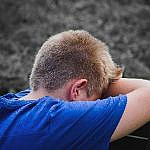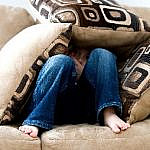There are 3 different types of diagnoses impacting learning and behavior in children. This post will be exploring sleep deprivation, social anxiety, and scotopic sensitivity syndrome. Recent research has shown that one or more of these diagnoses could have a direct impact on learning and behavior in children of all ages.
If you answer “YES” to any of these statements, one or more of the above diagnoses could be impacting your child’s learning and/or behavior.
- My child has been identified with ADHD or ADD.
- I think my child might be autistic.
- My child is angry all of the time.
- My child has trouble reading and nothing seems to help.
- Traditional educational practices are not working!
Sleep Deprivation Diagnosis
Most people have heard of this diagnosis relating to adults, but many don’t realize that children suffer from it to a great degree. According to the American Academy of Pediatrics, sleep deprivation affects 20% to 30% of children. Most children need at least 9 hours of good sleep a night. Signs of this diagnosis impacting learning and behavior can be sporadic.
A lack of sleep may cause:
(List taken from webmd.com)
- Accidents and injuries
- Behavior problems
- Mood problems
- Memory, concentration, and learning problems
- Performance problems
- Slower reaction times
- Overeating
Signs of sleep problems:
(List taken from webmd.com)
- Snoring
- Breathing pauses during sleep
- Difficulty falling asleep
- Problems with sleeping through the night
- Difficulty staying awake during the day
- Unexplained decrease in daytime performance
- Unusual events during sleep such as sleepwalking or nightmares
A constant lack of sleep can impact learning and behavior! Speak to your pediatrician. According to the Mayo Clinic, your doctor will assess the problem and might order the following tests to determine a better diagnosis:
Social Anxiety Diagnosis
The definition of “Social Anxiety” according the National Institute of Mental Health is:
Social anxiety disorder (also called social phobia) is a mental health condition. It is an intense, persistent fear of being watched and judged by others. This fear can affect work, school, and other day-to-day activities. It can even make it hard to make and keep friends.
Social anxiety has many similarities to autism or Asperger’s:
- eye contact
- body postures
- speech qualities, such as tone, volume, and rate
According to Katie Hurley, a child and adolescent psychotherapist, children with social anxiety can show the following symptoms:
- The person feels that he or she will act in a way or show anxiety symptoms that will be negatively evaluated
- The social situations always trigger fear or anxiety (in children this can manifest as tantrums, clinging, crying, freezing up, or failure to speak)
- Social situations are avoided or endured with intense feelings of fear and anxiety
- The fear or anxiety is out of proportion to the actual threat
- The fear, anxiety, and avoidance lasts for 6 months or more
- Causes clinically significant distress in social, occupational (school), or other areas of functioning
- Dread of social events that can occur weeks in advance
- Excessive clinging to familiar people
- Tantrums when faced with anxiety provoking social situations
- Blaming others for perceived social failures
- Physical symptoms: Blushing, racing heart, shaky voice, trembling, nausea, difficulty speaking
Any of the above can have a direct impact on learning and behavior. If you feel your child exhibits some or all of these behaviors, contact a mental health specialist or pediatrician so that they can provide the needed tools and/or medication that will help your child succeed. This diagnosis impacts the social and emotional aspects of learning, which in turn can affect behavior.
Scotopic Sensitivity Syndrome (SSS) Diagnosis
This diagnosis is one that many have never heard about, but it can have significant impact on learning and behavior. It was introduced by Helen Irlene in the 1980’s. It is also known as “visual stress” or “visual snow”. Irlene did extensive research with using colored overlay sheets on written pages for people having poor reading skills. She discovered that many of these people who were diagnosed with dyslexia, ADD, ADHD and assorted other learning disabilities had the same thing in common, the inability for the brain to adjust to various levels of brightness. This caused a distortion effect or “visual snow”.
Main Symptoms:
- Light Sensitivity that causes discomfort from:
- glare from car headlights
- glare from surfaces
- Fluorescent lights
- Bright sunlight
- Contrast problems-when there is a large difference in light and dark:
- Black text with a white background will seem to move or look like static
- Vertical or horizontal window blinds will look like they vibrate
- Stripy or bold patterns may look three dimensional instead of flat
- Reading difficulties that are not resolved from wearing glasses:
- Words on the page look like they move
- Words do not have spaces in between each other
- Part of the letters do not show
- Words on the page swirl around in a circle.
- Poor Depth Perception causes difficulty in judging distance:
- Bumping into things
- Clumsiness
- Attention and Concentration difficulties due to eyes feeling uncomfortable and sometimes painful:
- Difficulty staying on task
- The need to take frequent breaks
- Feeling restlessness while studying or reading
- Feeling tired and fatigue after reading or studying
- Headaches and Migraines can be triggered
Fact:
Irlen Syndrome or Scotopic Sensitivity Syndrome is not a problem with the eyes; it is a problem with the brain!
Solutions: (Click here to see all options)
- Use of colored overlays
- Print text, worksheets, etc. on colored paper
- Colored eye glass lenses
- Reduce fluorescent lighting
Learn more about this syndrome and how to identify it by going to https://irlen.com/ or reading Helen Irlen’s book: Reading by Colors. Test your child or yourself by going to Iren’s Self Testing.



